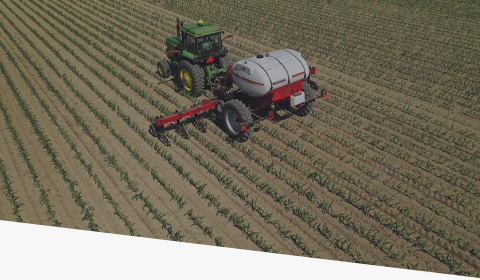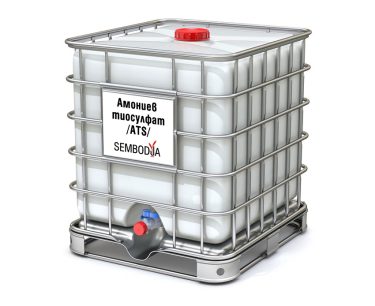- High quality source of sulfur in liquid form
- Acts as a natural inhibitor when mixed with UAN solution and thus reduces nitrogen losses; helps reduce nitrate build-up
- Improves phosphorus and trace element uptake in high pH soils
- Improves soil structure, increases soil water permeability, aids decomposition of plant residues from previous crops and enhances the effect of nitrogen uptake by plants
- Improves the protein and chlorophyll content of crops
- Increases the natural immunity of plants against phytopathogens
- Promotes the synthesis and functioning of enzymes in the plant
Ammonium Thiosulfate (ATS)
Ammonium Thiosulfate (ATS) is a liquid fertilizer that helps increase yields by providing plants with the essential elements nitrogen and sulfur. Mixing ammonium thiosulfate with UAN (urea ammonium nitrate) is beneficial, efficient and appropriate solution for stabilising and increasing the efficiency of the nitrogen input.
In combination with Urea Ammonium Nitrate (UAN): the product can be mixed in different ratios for soil and foliar application.
UAN is an efficient and balanced source of nitrogen, providing excellent value for money. It can be applied foliar and soil over wide areas. It is easily mixed with ATS and the resulting mixtures are also easy to apply. For optimum results, it is recommended that the ratio of ATS to UAN solution be 10% to 30% w/w.
What advantages does mixing UAN with ATS give you:
- Ammonium fertilizer with a slow-release effect ensuring uniform plant growth
- Reduced ammonia volatilization
- Conversion of ammoniacal nitrogen to nitrate nitrogen is delayed, the risk of leaching is reduced and thus more nitrogen is available to the plants
- Less nitrogen loss due to lower mobility of ammoniacal nitrogen in the soil
- Stimulates root growth
- Ensures continuous replenishment with nitrogen and sulfur through the thiosulfate component
- Helps increase yields along with the quantity and quality of proteins
An advantage of UAN + ATS mixtures is that nutrients can be mixed in different proportions, e.g. 27% N + 3% S (6.5% N-NO₃, 7.5% N-NH₄, 13% N-urea) or 24% N + 6% S (5% N-NO₃, 8% N-NH₄, 11% N-urea). Fertilization with these mixtures is of potential interest to those seeking to:
- Minimize nitrogen losses
- Beneficial fertilizer storage
- Simplified fertilizer logistics
- Efficient and beneficial inventory management
ATS mixtures should not be acidified below pH 6.
- High quality source of sulfur in liquid form
- Acts as a natural inhibitor when mixed with UAN solution and thus reduces nitrogen losses; helps reduce nitrate build-up
- Improves phosphorus and trace element uptake in high pH soils
- Improves soil structure, increases soil water permeability, aids decomposition of plant residues from previous crops and enhances the effect of nitrogen uptake by plants
- Improves the protein and chlorophyll content of crops
- Increases the natural immunity of plants against phytopathogens
- Promotes the synthesis and functioning of enzymes in the plant
In combination with Urea Ammonium Nitrate (UAN): the product can be mixed in different ratios for soil and foliar application.
UAN is an efficient and balanced source of nitrogen, providing excellent value for money. It can be applied foliar and soil over wide areas. It is easily mixed with ATS and the resulting mixtures are also easy to apply. For optimum results, it is recommended that the ratio of ATS to UAN solution be 10% to 30% w/w.
What advantages does mixing UAN with ATS give you:
- Ammonium fertilizer with a slow-release effect ensuring uniform plant growth
- Reduced ammonia volatilization
- Conversion of ammoniacal nitrogen to nitrate nitrogen is delayed, the risk of leaching is reduced and thus more nitrogen is available to the plants
- Less nitrogen loss due to lower mobility of ammoniacal nitrogen in the soil
- Stimulates root growth
- Ensures continuous replenishment with nitrogen and sulfur through the thiosulfate component
- Helps increase yields along with the quantity and quality of proteins
An advantage of UAN + ATS mixtures is that nutrients can be mixed in different proportions, e.g. 27% N + 3% S (6.5% N-NO₃, 7.5% N-NH₄, 13% N-urea) or 24% N + 6% S (5% N-NO₃, 8% N-NH₄, 11% N-urea). Fertilization with these mixtures is of potential interest to those seeking to:
- Minimize nitrogen losses
- Beneficial fertilizer storage
- Simplified fertilizer logistics
- Efficient and beneficial inventory management
ATS mixtures should not be acidified below pH 6.


